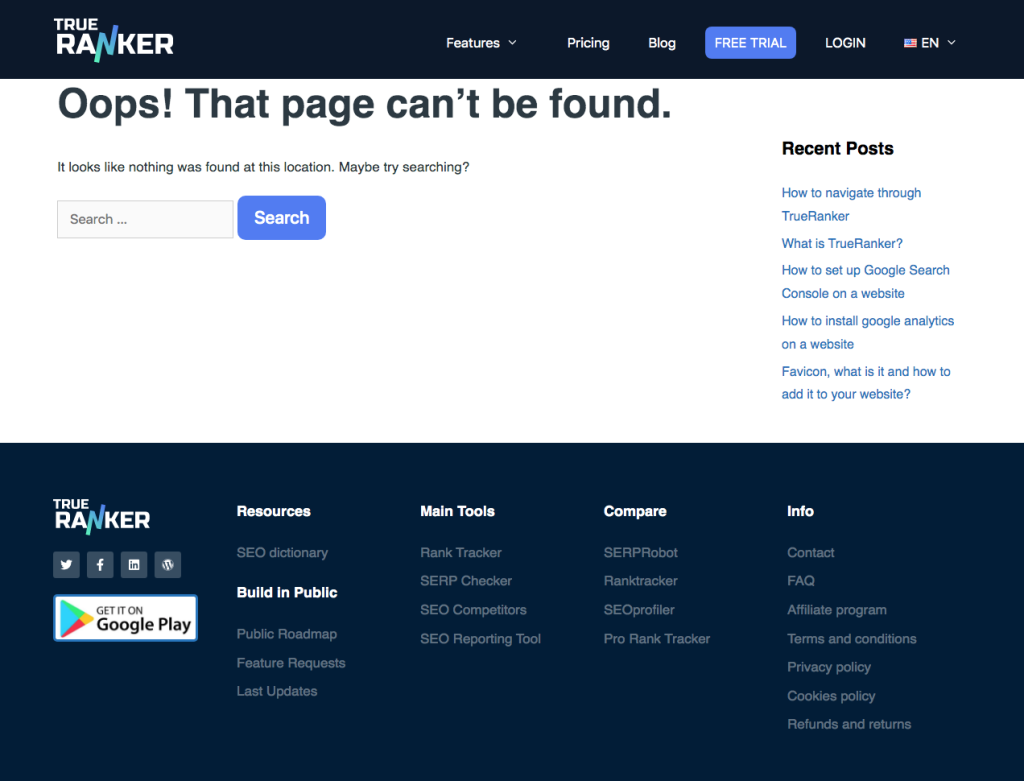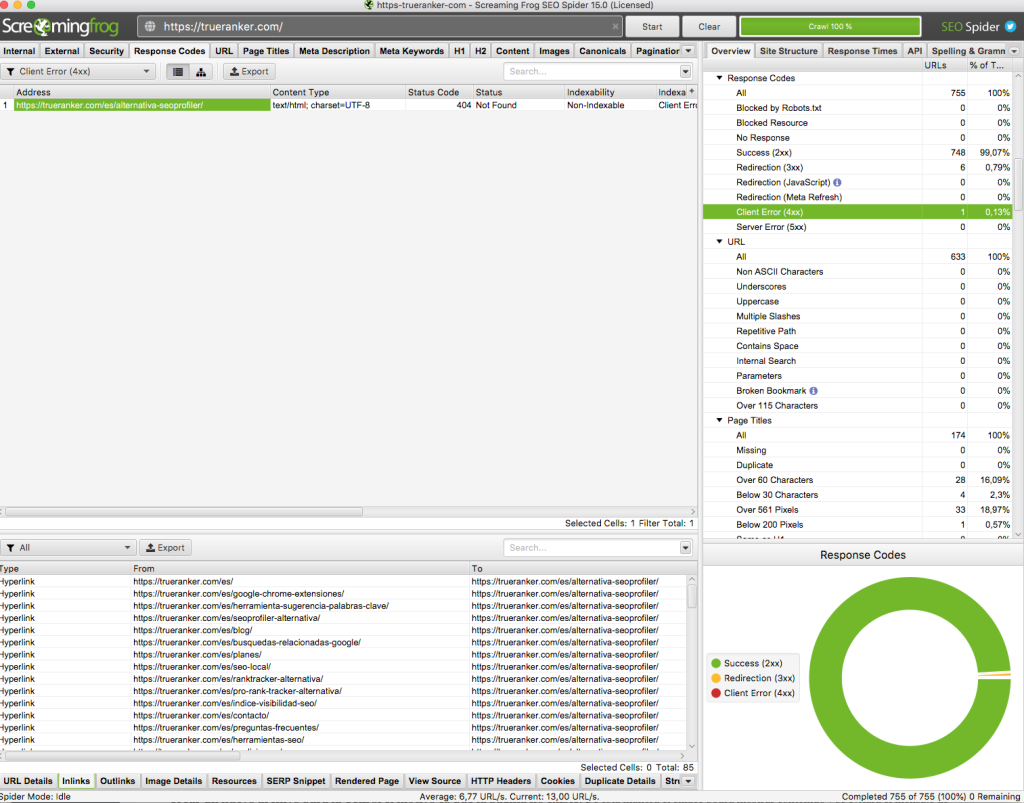A common navigation problem encountered by users visiting a website, blog or online store is the 404 error. Instead of accessing the content of the site, the web browser displays a message indicating that a 404 error has occurred.
Detecting 404 errors is a priority task for any website due to the negative consequences of users not being able to access the website (for example, in relation to the image and prestige of the site, or on conversions).
Despite the unfavorable impact that these errors have on a website, their solution is simple and fast, so the key is the constant detection of 404 errors.
Contents
ToggleWhat is error 404
The 404 error is a message displayed by the web browser when the user tries to access and an error occurs, which is usually related to a broken or incorrect link, thus preventing access to the content.
This message can be displayed in various forms such as 404 not found, Ooops… Error 404, 404 page not found, and other similar messages.

If the link to a page is broken, defective or does not exist, the user will receive this 404 error in the web browser being used when trying to access that URL.
There are many reasons why this type of error can be accidentally displayed on a website, such as if the slug (the text following the domain in a link) is changed or if the content is accidentally moved or deleted.
You can read more about what a 404 error is by clicking here.
Consequences of a 404 error on a website
As we can deduce, if an e-commerce or web page shows 404 error messages in some of its URLs, the consequences for the site will be negative at different levels.
Penalization of web positioning
SEO is essential for a website to be placed in the best positions in the results pages and to increase its visibility and conversions in a remarkable way.
If a website has pages with the error 404 will be ruining the user experience and Google will end up penalizing its web positioning. The 404 error has a negative impact on a website when it comes to positioning in the SERPS, so it is very important to detect and correct them as soon as possible to avoid these Google penalties.
It is important to note that if Google bots detect a 404 error, it is possible that they will deindex the website from their database, that is, it will no longer be shown on Google’s results pages. This is one of the main reasons why it is essential that you constantly detect possible 404 errors that your website shows because you can solve them quickly to prevent the page from being deindexed (thus losing all the effort and investment made to position it).
Increases dropouts
If a user is browsing the product pages of an online store, the articles of a blog, or the pages of a website, they will probably abandon it if they encounter a 404 error message.
When a website has many broken links or pages that have changed URLs if they have been redirected correctly, you will see the number of users leaving the site in search of an alternative website increase considerably.
Negative impact on image and prestige
Another negative aspect of 404 errors is that they have a negative impact on the image projected by the site to users. A website with pages displaying 404 error messages will decrease the prestige of the site.
Detect 404 errors step by step
Given the importance of detecting and correcting 404 errors on a website, let’s see how they can be identified quickly and easily using a specific SEO tool (with Google Search Console you can also access a report of URLs with 404 errors).
1. Install Screaming Frog – SEO spider
The Screaming Frog – SEO Spider tool is very interesting to analyze a website and optimize it to improve its performance and positioning on Google. Installing this SEO platform is one of the best alternatives to quickly and easily detect the different 404 errors due to bad links or redirects that a website has.
2. Make a complete analysis of your website
Performing a complete analysis of the site with Screaming Frog – SEO spider will provide a lot of valuable information to improve and optimize it. Once this analysis is done, the tool will detect all 404 errors that are present on the website, making it easier for the user to access information about them to solve them. Enter the URL of your website at the top of the Screamin Frog screen (where it says “Enter URL to spider”).
3. Check the 404 error report
In order to view the location of the 404 errors that a site is displaying after performing a complete analysis of the website, you will need to consult the reports presented by the tool.
By going to the option Overviews / Response Codes / Client Error 4xx, a report with a list of the site’s URLs will be displayed. By clicking on each 404 Error at the bottom of the screen, you will be able to see on which page the error is being generated (“From” column).

How to fix 404 errors
Fixing 404 errors should be a priority for your website to ensure that users enjoy the best user experience, thus avoiding all the negative consequences that this error has for SEO and the image of your site.
Let’s take a look at some ways to fix 404 errors on your website:
Change the URLs that generate errors
If a page is displaying this error, one of the possible solutions is to change the URL, which can be done in two ways.
- Create a new file for the URL if the reason is that the page does not exist. This way the link will be able to display content and the error message will be avoided.
- Replace the web file if it is damaged or defective so that the content can finally be displayed in users’ browsers.
Creates redirects to pages that do exist
Redirects are the ideal solution to avoid many of the 404 errors that a website presents. This process consists of assigning a new web address to which the site is redirected so that the user accesses a different URL even though he/she is entering the original URL.
With the redirection it is possible to eliminate the 404 error message, making the user access the content he was looking for, although guiding him to a new page.
This web redirection can be done in two different ways:
- 301 or permanent redirection. This is a permanent redirection of the website, i.e. the URL will definitely point to another part of the website.
- 302 or temporary redirection. It is a provisional or temporary redirection, to avoid showing the navigation error until the cause of the error is solved.
Create a 404 error page
A very interesting alternative to mitigate or minimize the negative consequences of 404 errors on your website, is to create a custom 404 error page. This is to build a page that displays a custom message and replaces the default pages displayed by web browsers when a 404 error occurs.
The advantages of using a custom page for 404 errors are:
- Allows you to add a link so that users can use it to access another page of the site. This prevents users from abandoning the site, so they stay longer browsing your content.
- It facilitates the creation of a more attractive and less shocking environment when the error is displayed (visually more attractive), showing a personalized message of apology to the user for this situation (closer relationship with the user and projection of concern for his experience on the web).
Verify that it is not a temporary error
Many times the 404 error occurs temporarily, either because of a specific server problem or internet access or because of problems with the web browser itself. For this reason, it is very important to use tools such as Screaming Frog – SEO Spider, Dead Link Checker or Google Search Console to detect 404 errors, as this way you will be able to discard messages that are due to temporary access errors.
The 404 error is a navigation problem that shows this error message and is directly related to a problem in the links or URLs of the site. This is a common error that you should constantly monitor on your website in order to detect them in time and minimize their negative impact on the site.
Fortunately, correcting the 404 error is a simple process that can be done using different techniques, such as temporary or permanent redirection, or repairing or replacing the URLs that present the error message.
Constantly monitoring your website for 404 error pages and implementing actions to fix them as soon as possible should be a priority for your website, blog or online store.

